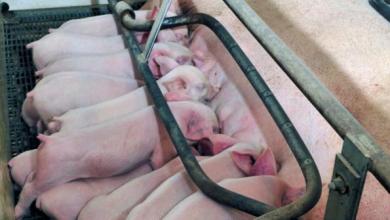Improving Iron Status in Piglets
Posted: December 6, 2017 | Written By: Gary Asche, Ph.D., Form-A-Feed Nutritionist

Piglets have about 50 mg of iron at birth. Due to their fast growth rate, pigs need 8 to 16 mg of iron per day. Thus, piglets can become deficient in iron within three days of age if not given supplemental iron due to sow’s milk being very low in iron (about 1 ppm). The most common source of iron is a 200 mg injection of iron dextran given in the first day or two after birth.
There have been a few recent studies evaluating iron status of young pigs. One study from 2015 showed that 35% of pigs weaned were marginally deficient in iron (anemic) with blood hemoglobin levels below 11 gram/dl, even though all pigs received a 200 mg iron injection soon after birth. Pigs that were anemic at weaning were also 1.8 pound lighter than pigs with normal iron status. The level of anemia also increased to about 60% in pigs three weeks after weaning despite the iron supplemented feed. The high level of zinc oxide in the nursery feed may have interfered with iron absorption.
Other minerals (calcium, phosphorus, zinc, manganese and copper) at high levels share the same transport mechanism in the intestine as iron. Piglets prior to the PED virus commonly were fed highly digestible animal proteins such as plasma, fish, poultry, peptone or blood meal which contained good quantities of high bioavailable iron from hemoglobin fraction of blood. More recently, with the focus on all vegetable based formulas, animal proteins are replaced with modified soy proteins (soy isolates, soy concentrates, fermented or enzyme modified soy proteins) or yeast products which are lower in iron and higher in phytate content. This causes lower levels of bioavailable iron. The higher level of phytate can bind iron, reducing absorption of iron. This is because phytate is a strong chelator of metal ions.
What are some strategies that can help improve iron status in young pigs? One possible solution is a second iron injection, however this isn’t commonly done in the field. Much of the concern with high phytate impacting iron is being solved by using higher levels of the enzyme phytase. Phytase enzyme breakdowns phytate which is the main form that plants use to store phosphorus. The industry has evolved to use high levels of phytase in starter feeds which has improved growth performance beyond phosphorus release and shows that phytate was depressing performance much more than we realized. There is research (Mansbridge, 2016) showing that reduced phytate content in the intestine is related to higher blood hemoglobin level in pigs at three weeks post-weaning. There is also recent data showing that higher levels of phytase (500 and 2,500 FTU/kg) and increased iron levels in the diet from 100 to 320 ppm improved iron status in pigs based on percent hematocrit (higher proportion of red blood cells in blood). Form-A-Feed has been using these high levels of phytase in young pigs diets for several years.
One other approach is providing a portion of the trace minerals in an organic form where the metal is attached to an amino acid instead of feeding all of the trace minerals as inorganic sulfates or oxides. The high levels of zinc oxide (3,000 to 4,000 ppm) commonly used to help reduce diarrhea and looseness in piglets can also be reduced and/or fed for a shorter time period to improve iron absorption by less zinc competing for absorption. Form-A-Feed has been formulating diets below 3,000 ppm of zinc oxide which indirectly improves iron status in young pigs.
The larger litter sizes from today’s highly prolific sows puts enough stress on young piglets. Increases in iron supplementation are not expensive; chelated iron has recently been added to Form-A-Feed’s Intensive Care Formula. The growth depression from anemic piglets is a large enough issue to put more of an emphasized focus on improving iron status.